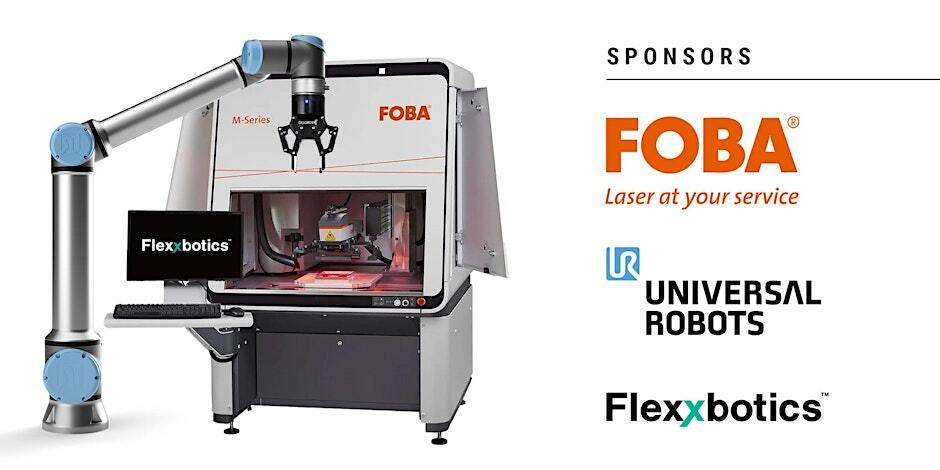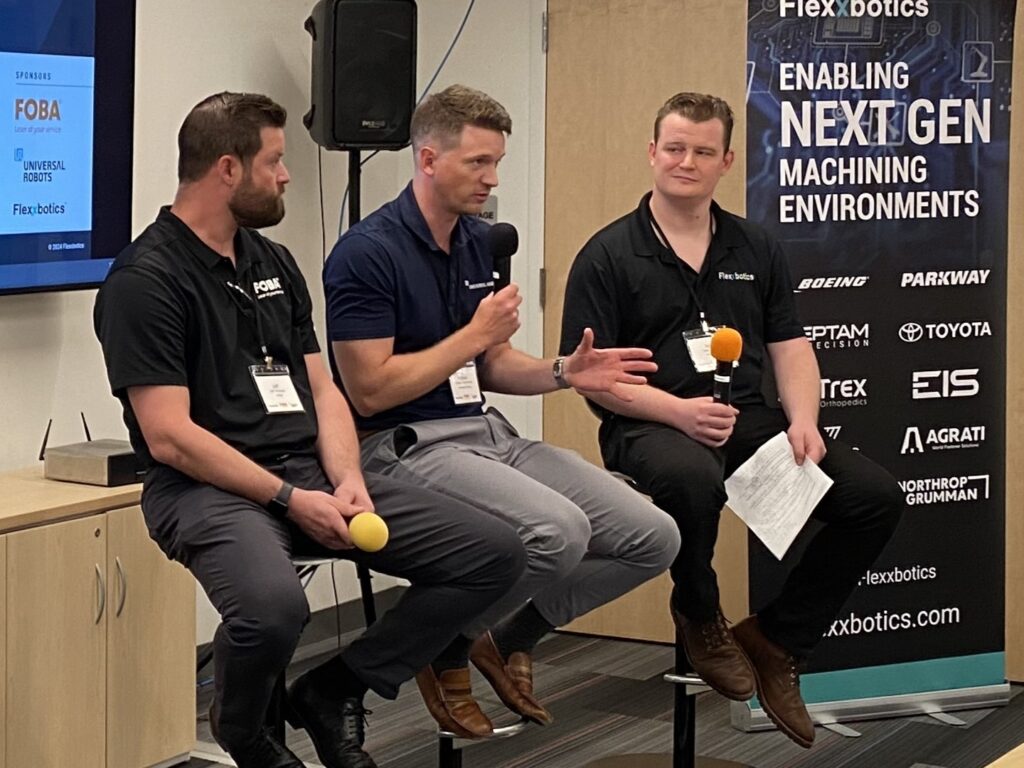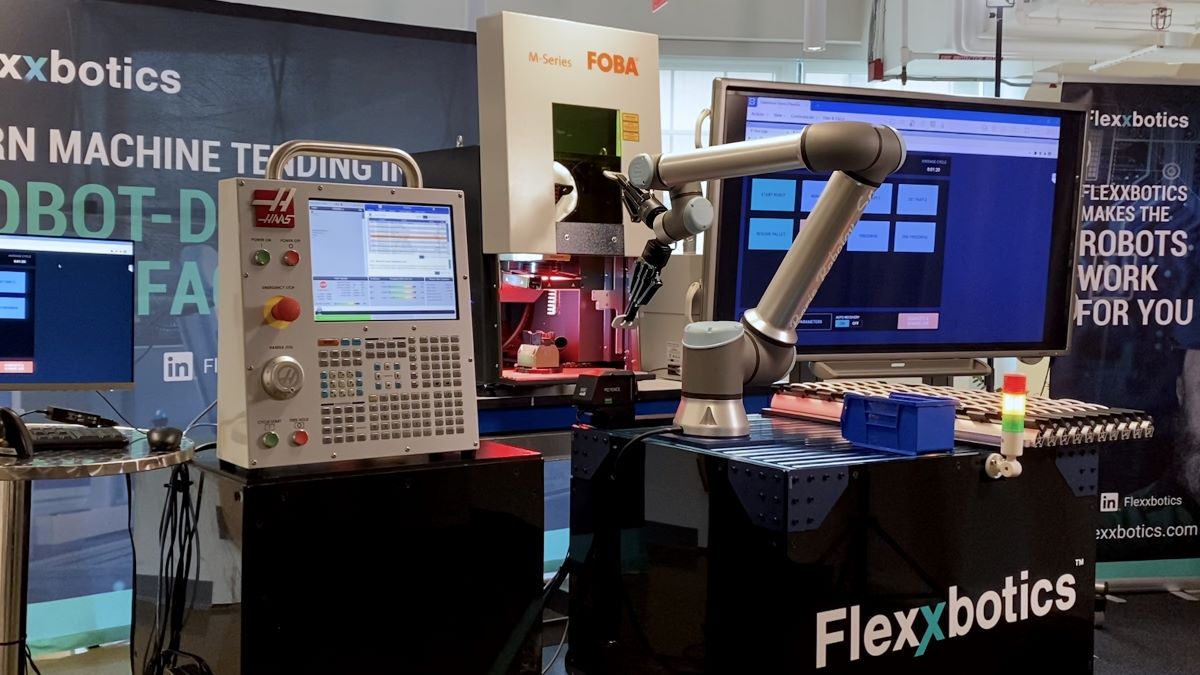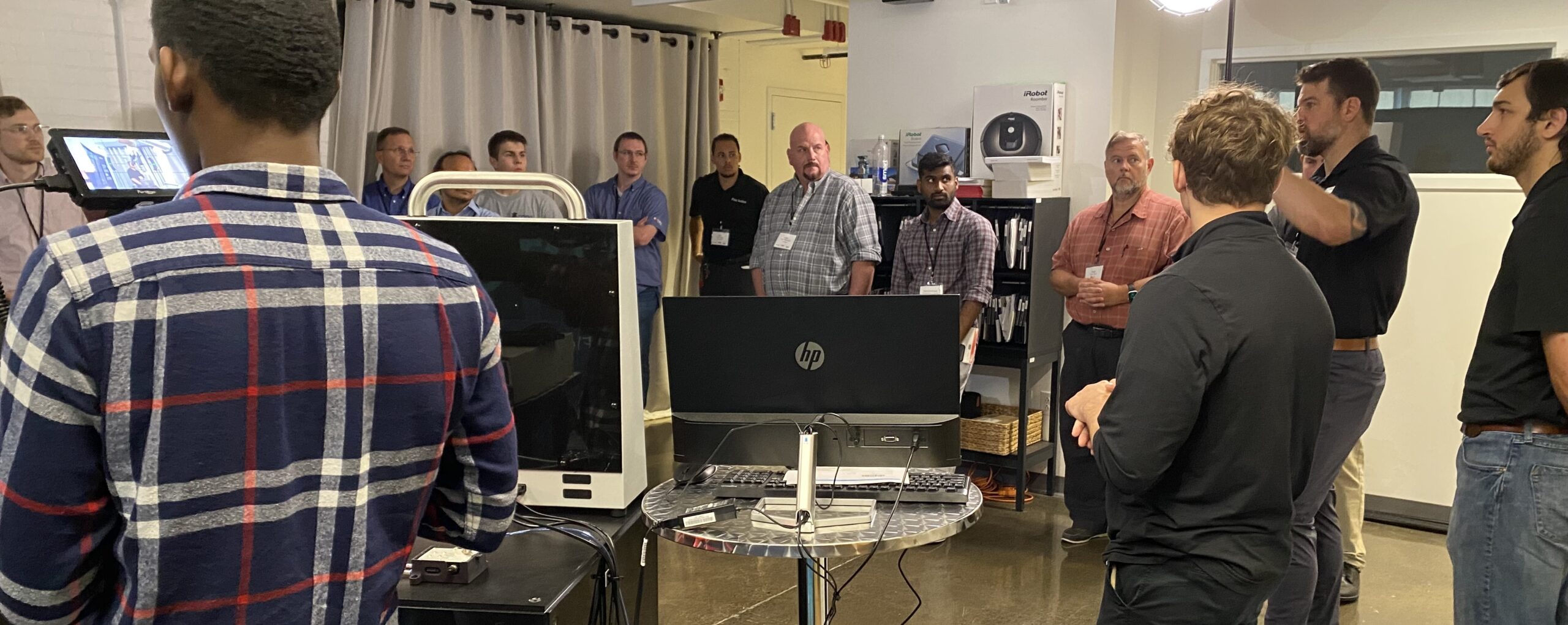
By Tyler Bouchard 08/05/2024
Event Summary: Transforming Laser Marking Operations with Collaborative Robotic Automation
Click here to download all the presentation slides
Want to thank everyone that joined us for our Transforming Laser Marking Operations with Collaborative Robotic Automation event held by FOBA, Universal Robots and Flexxbotics.
We had great turnout with some people flying from across the country and others road tripping from all over the Northeast. It was great to see so many interested in this topic and in my opinion face-to-face is always best for discussing these types of smart factory production robotic automation initiatives.
This is a hot topic because laser marking and engraving plays a critical role in many manufacturing environments ensuring unique part identification (UID) for compliance, particularly in highly regulated industries like medical devices, defence and aerospace.
Laser marking operations often face significant challenges with increasing output demands as capacity ramps and labor/skills shortages which make them excellent candidates for robotic automation. To address these issues, forward-thinking manufacturers are turning to advanced robotic machine tending, which was the central theme of our event.
Event Highlights
There was an excellent lineup of speakers with real depth in the fields of laser marking, collaborative robotics and robotic digitalization presenting on a variety of topics from challenges and considerations to best practices and real world examples.
The real Star of the event was the workcell demonstration set-up which included:
- FOBA M-Series Laser Marker,
- Haas PLC (simulated CNC operation),
- Keyence Telecentric Measurement System for in-line inspection, and
- a UR10 Cobot in an advanced robotic machine tending configuration with
- Flexxbotics software solution enabling everything to communicate and operate in a coordinated way

There were 2 part type SKUs with different geometries being processed through each step so material enters as raw stock and completes as a finished, laser marked part. Flexxbotics managed all the machines and the robot along with automated part/job set-up and changeover of the entire cell while everyone watched.
Additionally, Flexxbotics instructed the cobot to identify and sort defects, and then based on the inspection results, adjusted the FOBA and Haas programs’ offsets in real-time to correct any processing issues for Autonomous Process Control.
The demonstration provided a real-world example of how cobot-enabled laser marking operations can substantially increase throughput while reducing defects and improving yields.
Digital Orchestration of Collaborative Robots in Laser Marking
Using cobots in laser marking operations can boost efficiency and productivity, yet achieving coordinated operation can be particularly challenging. Utilizing cobots from Universal Robots and our Flexxbotics software solution, companies running FOBA Laser Marking & Engraving systems can achieve a machine-to-man ratio of 10:1 or more to enable safe ‘lights out’ production for:
- Additional Capacity
- Precision Quality
- Improved Margins
Expert Insights
During the presentations industry experts in their respective fields shared their experiences with robotic automation in laser marking.
Robotic Automation and Lean Manufacturing Applied to Laser Marking
Faycal Benayad from FOBA, explained how collaborative robotic automation combined with lean manufacturing principles can dramatically improve your laser marking process output. He highlighted how robots reduce waste including production defects, unnecessary downtime, inefficient movement, and operator errors. Faycal also shared success stories from the automotive and medical device industries, demonstrating how robotic automation has significantly increased capacity and yield.
Getting Started with Cobot Automation in Laser Marking Operations
Silas Neale from UR, went through the key considerations in selecting the right cobots for your laser marking operations. He contrasted traditional automation with collaborative robots, and how to choose the best cobot model for your specific needs to improve laser marking. Silas also covered how to spot the scenarios best suited for cobot introduction, where to start and how to define the business case for your initiative.
Running Advanced Robotic Machine Tending with Laser Marking & Etching for Continuous Operations
My session went through the different stages of production robotic automation maturity and what to take into account specifically for putting cobots on laser marker equipment. It covered things like Job/SKU management & changeovers, part geometry, in-feed/out-feed, workholding, robot+machine interfacing & communication, process coordination and other important considerations.
Afterward, we all broke into groups of 10 and each group got a tour of the demonstration running. While a group went out to see the set-up in action, everyone else participated in an ‘ask the experts’ panel discussion. The audience had a ton of great questions getting right to the practical points necessary to deploy cobots in their factories.
Overall it was a really great event and I’m glad so many of you were able to join, thanks for coming.
Want to also take the opportunity to thank all those that contributed to making the day a success; everybody that helped out at FOBA, Universal Robots, MassRobotics Center, and of course Flexxbotics – Thank you all!
Click here to download all the presentation slides
Complete Demo Description
OVERVIEW
- Cellularized Setup Equipment
-
- UR10 – Universal Robot
- Haas CNC Controller Simulator
- Keyence Telecentric Inspection Device
- FOBA M Series Laser Marker
- Flexxbotics solution machine interface edge device
-
- Simulating the automation of a part through each of its processes so it enters as raw material and completes as a finished laser marked part
- Flexxbotics Software Solution
-
- Enabling interoperability between all the machines with each other and the robot
- Facilitating the information flow for parts and order setup
- Managing all communications between the robot, CNC, Inspection, and Laser
- Providing advanced functionality such as Autonomous Process Control
-
OPERATOR SETUP
- Process kicks off in Flexxbotics software by Barcode scanning the traveler or manually selecting a part number and entering the work order information
- Flexxbotics solution provides the Part SKU Management for the robot and all the machines
-
- Operator reviews the part, operation, and specifies the work order to be run
- Flexxbotics then pulls the part and order information from its database and distributes it to the robot to be used during runtime, this is an automated process or can be preformed manually
- Information distributed: lot numbers, dimensions, quantities and each robot and machines’ programs that need to be executed for the parts, work order, or any other parameters about the cell
-
- Part of the HMI includes Simple, Standardized “Big Button” Operator Controls (i.e. just a few big buttons on the screen)
- The buttons start the robot, set SKU’s, make runtime changes
- Buttons are customizable with the ability to control a variety elements of the cell utilizing Flexxbotics communications
DURING OPERATION
Universal Robot
- UR10 cobot arm with built in safety via Power and Force Limiting technology which allows for a more open and collaborative workcell layout
- Flexxbotics is using the robot controller and UR’s Polyscope operating system to control the sequence of events
- Flexxbotics software is directly tied to the robot so the robot is equipped with all information provided from the Flexxbotics setup
- The robot is utilizing the Flexxbotics software to communicate and coordinate with the various machines
- Flexxbotics software is able to capture all events coming from the robot including statuses from the robot and all the machines, as well as, counts and variables
In/Out Feed
- Customized pallet infeed w/ tilted part presentation for consistent robot pick-up / return, other options available as well depending on part type, size, weight and other factors
- Can be for raw stock or complex part geometries
- Robot uses a pallet routine to sequence through parts
- Flexxbotics software tracks pallet progress and knows when to change to next pallet autonomously
- Added benefit is multi-order staging to increase robot unattended time
Gripping
- Robotiq Dual 2F-140 Electric Grippers
- Variable stroke length provides flexibility
- I/O feedback allows Flexxbotics solution to check for grip success and make adjustments if needed
Haas PLC Controller CNC Simulator
- Part gets loaded into Schunk Pneumatic Vises w/ Custom Soft Jaws actuated by the Flexxbotics software
- Flexxbotics software then loads the program and writes any macros required for run-time
- Flexxbotics starts the cycle and begins monitoring the machine state for end cycle completion or any unforeseen CNC alarms
Keyence Telecentric Inspection
- Telecentric optical measurement of the width of the internal cuts of the part
- This can be a pre- and/or post- inspection of the parts
- Flexxbotics software reads measurement values and compares them to the part’s Tolerance and Control Limits specs saved in Flexxbotics
- This comparison calculation is used to sort pass / fail parts, as well as, produce SPC values used by the Flexxbotics software for autonomous process control (see further explanation in section below)
- Other automated inspection technologies can also be use such as probes, vision, CMMs and others
- In-line inspection is optional, yet important for ‘lights out’ operation of a cell to ensure parts are being made to spec
FOBA Laser Marker
- Flexxbotics loads the appropriate job into memory on the Laser Marking machine utilizing the part(s) specified during Operator Setup
- Flexxbotics then uses the order data from the setup process to sequentially set the lot id and serial number via a variable in the laser program
- Flexxbotics then closed the FOBA door and starts the FOBA laser program which utilizes the job information that was also sent over from Flexxbotics
- With Flexxbotics managing both the FOBA<>UR’s operations multi-order staging is achievable
-
- Running sequential orders with different parts requires new FOBA jobs along with variable changes which Flexxbotics enables
- The entire process is automated through Flexxbotics to the UR Cobot and the FOBA system without operator intervention
-
- Flexxbotics also ties in with FOBA’s Intelligent Mark Position (IMP) feature utilizing the internal camera to perform edge detection of the part as a reference point for accurate placement location prior to performing the marking
-
- Flexxbotics reads the “confidence level” from IMP
- And if confidence level is outside the established threshold for the part (generally 85% or above) Flexxbotics will detect and instruct the robot to re-place the part
- This accuracy detection occurs before the mark is even made assuring autonomous defect avoidance
- This is also beneficial when changeover requires multi-use fixturing or the robot to hold the parts
-
- This level of coordinated operation between the FOBA and the UR cobot is only possible (without man years of custom coding) with Flexxbotics due to our patent-pending FlexxCORE technology which securely connects robots+machines for interoperability
PART CHANGEOVER
- A new part is run by scanning another barcode or pushing a button on the Flexxbotics software screen
- Operator completes job and uses either traveler barcode or does part number selection
- All programs and parameters for the new part get loaded and distributed by Flexxbotics
- Now, the Robot knows how to run the next part and the programs for the FOBA, the Haas and the Keyence are all synchronized as well
- Changeover can also be done by Flexxbotics automatically changing to the next part using multi-part staging in the same infeed
AUTONOMOUS PROCESS CONTROL (APC)
- APC is the ability to make production processing corrections or adjustments without human intervention / autonomously
- Using inspection results Flexxbotics APC makes corrections to the Haas PLC’s g-code based on data from:
-
- Critical characteristic and tolerance measurement data from the interior width of each part
- Utilizing Statistical Process Control Limits in real-time to identify trends in results
- Determining an offset to automatically compensate the machine for a tool’s wear by writing a macro
- Utilize inspection feedback to ensure the laser mark position is consistent
- Benefits include assuring high yields in ‘lights out’ operations where operators are not present to make corrections
-
- Other use cases of autonomous process control include the Flexxbotics Intelligent Recovery capability for recovery from non-safety related robot stops
-
- Automatic pick-and-place fault recovery
- Error or collision stop auto-recovery
-
EVENT TRACKING & ESCALATION
- Data are tracked on all events that happen during automated operation for all machines and robots connected to Flexxbotics
-
- This digital thread is critical for high compliance industries like medical device, aerospace, defense, and automotive as it provides a robot audit and event log for all the machines in the workcell
- It is especially important for lights out environments
-
- Flexxbotics detects and can escalate an issue if one occurs
- Event tracking also feeds Flexxbotics Intelligent Recovery which auto-corrects from an anomaly if detected through the event stream
- Crucial to keeping production running at a high utilization
ROBOT CONTROL CENTER
- Two key aspects critical to the scalability of robotics across the smart factory are visibility and actionable information
- Flexxbotics software provides control room dashboards for all robots, machines and inspection equipment operating simultaneously across the smart factory or in multi-factory scenarios
-
- Plant executives, managers and operators with permissions can see robotic production as it occurs in factories around the world from phones and tablets
- Manage all parts and jobs that the robot are configured to run
- See dashboards with real-time status and trend data on output and quality metrics
- Get downtime alerts and escalations in either text, email or both with clickable links to go straight to the issue
-
If you have any questions about the items covered in this demo or other types of installations, contact us



